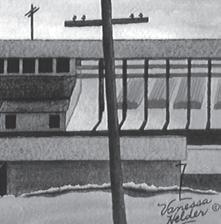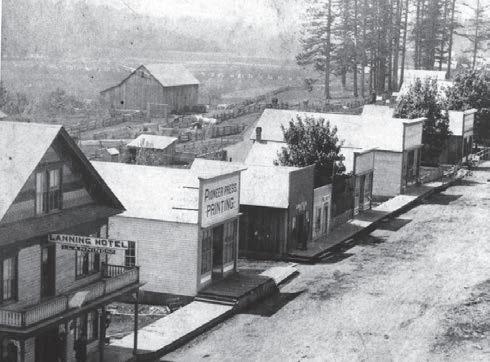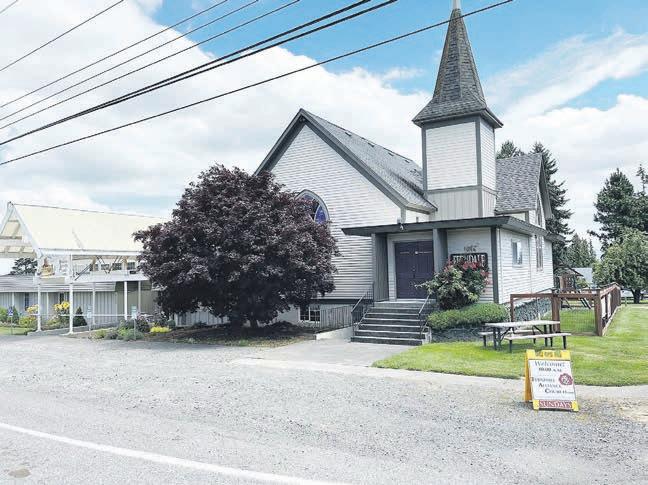







































































































































Daily




1PM Fri | 1:30PM Sat: Flag Presentation and National Anthems by FERNDALE HIGH SENIORS
Welcome by Mayor Greg Hansen and WCOSA’s President Lynda Lucas Honoring the “Oldest Local Old Settlers in Attendance”
2PM-7PM Fri | 1PM-7PM Sat: Whatcom Genealogical Society, “Family History Fun and Exploration” in the Pioneer Pavilion
12PM-6PM: Pioneer Cabins
11AM-Dusk: Craft & Food Vendors
12PM-7PM Fri | 1:30PM-7PM Sat: Children’s Activities & Passports
Friday (Senior Day)
ELVIS IMPERSONATOR (Danny Vernon & wife Marcia), Main Stage


CHRIS ANDERSON, Main Stage FREE RAIN, Main Stage
Saturday
9AM-2PM: PIONEER CAR SHOW, Central School Grounds (entrance on 1st Street)
11AM-12:30PM: “WE’RE BACK!” Grand & Junior Parade, Downtown Ferndale
2:30PM: MT BAKER TOPPERS, Main Stage

3:30PM: FERNDALE HIGH SCHOOL TALENT, Main Stage
5PM-8PM: FOSSIL ROCK, Main Stage
9PM-12AM: SOUTHBOUND Hard Country, Barn Dance, $5 door charge


Free Rain
Southbound Hard Country







 By Bill Helm Editor
By Bill Helm Editor
FERNDALE — Founded in 1910, the Boy Scouts of America have seen more than 130 million young men and women participate in the organization’s programs.
In 1947, two of those young men, Dale Brinkman and Joe Clarkson, traveled from Ferndale to France to attend the annual World Boy Scout Jamboree.

Now 90, Dale now lives in Seattle with his wife, Anita, age 89. Married since 1954, Dale has signs of dementia nowadays and “has great di culty expressing his thoughts,” his son Dan said recently.
“I knew a story had to be written before he would no longer be able to add any insights and because of the 75th anniversary of the event,” said Dan Brinkman, 63. “I suppose this is a way for me to honor him while he is still with us.”
Nearly 60 pages long, Brinkman’s story describes his father’s trip in ’47, as well as other Scouts’ experience as recorded in journals, correspondence and newspaper articles. e story is called Dale and Joe’s Excellent Adventure: Two Small Town Boys Experience the World Stage
As he put the story together, Dan Brinkman also scanned and photographed each of the items and they are listed as appendices to his story.


“This includes all of the photographs taken by Joe and Dale, with captions,” he said. Eagle Scout
Best as Dale and his son
See Brinkman on 4

Editor’s note: e following is an exerpt from Dan Brinkman's story Dale and Joe’s Excellent Adventure: Two Small Town Boys Experience the World Stage contributed to this story.
In 1907, the Boy Scouts organization was founded by Robert Baden-Powell in England. As it grew, the founder had a vision for a gathering of representatives of Scouting from all around the world. e general aim was to foster a worldwide brotherhood, and to help the young Scouts in the movement learn about other peoples and nations by direct interaction with them.
Continued from 3
Dan can surmise, January 1946 is when the elder Brinkman rst became involved with Boy Scout Troop 26 in Ferndale.
at year, Dale Brinkman became a patrol leader and earned his tenderfoot scout, second class scout, rst class scout, and star scout ranks. In February 1947, he earned his Life Scout rank. On Aug. 5, 1947, Dale Brinkman received his eagle scout rank.
“He had ful lled the requirements for the Eagle Scout rank, but there was a waiting period before it could be awarded,” Dan Brinkman wrote in his story. “He wanted to attend the Jamboree as an Eagle Scout with the insignia on his uniform shirt so he appealed to the Scout Council and they granted his request and waived the time period.”
On the trip, Dale Brinkman “kept everything,” Dan Brinkman said. At this time, the Lynden Pioneer Museum is preparing an exhibit of that trip before the items are sent to the National Scouting Museum in Cimarron, New Mexico.
“At rst, I thought that only my parents would be interested in this story,” he said. “But I won-
dered if others might as well. So I contacted the National Boy Scout Museum and asked if they were interested in housing the items permanently, and they were. en, the Lynden Museum said they would like to do a temporary exhibit. So, I am just sharing what I thought was only a family story with a wider audience.”
Brinkman explained that his father had journaled and that it was “a bit hard to read his handwriting, so I typed it out.”












“ en I organized a timeline and started lling in the story with all of the material he had kept,” Brinkman said. “When I discovered that Joe (Clarkson) had written letters to the Ferndale Record, I went to the library and found some more newspaper articles that my dad didn’t have. en I researched other Scouts who had written about their experiences to their home newspapers and added their insights. I kept adding stu until I felt I could understand what had transpired.”
115 years and counting Fascinated with his family’s genealogy, Dan Brinkman has written what he called long stories about various family topics he found interesting.
The first World Jamboree was held in 1920 in London, England and was attended by 8,000 scouts from 20 nations. e second was in 1924 at Ermelunden, Denmark with 6,000 scouts from 36 nations. e third in Birkenhead, England in 1929 with 25,000 scouts from 69 countries in attendance, and the fourth in Godollo, Hungary in 1933 with 28,000 scouts attending from 33 countries.
The fifth Jamboree was in Vogelenzang, Netherlands in 1937 with 37,000 scouts from 54 countries in attendance
This was the sixth World Jamboree organized for the Boy Scouts and the first one after Baden-Powell’s death in 1941. It was originally scheduled for 1941, but World War II interfered with those plans. Fittingly, it was named the Jamboree of Peace, or Jamboree de la Paix in French.
e o cial registration was 32,000 Scouts and Scouters. Of
Continued from 4
the total number 15,000 were French; Great Britain’s delegation was the second largest with 7,000, Belgium the third (2,000); United States fourth (1,050), and Holland and Switzerland with 1,000; 3,000 French Rover Scouts and 2,400 French Girl Guides and Lady Cub Masters aided in handling Jamboree activities.

Program highlights included the opening show where 40,000 people took part and all nations passed in review. Another highlight was the visit of the President of the Republic of France.
In addition, the U.S.A. show with the delegation depicting the dancing of American Indians, the coming of the pioneers to America, and a ceremony making Baden Powell a member of an In -
dian tribe was dramatic. And nally, the closing ceremony with all delegations marching over ramps on the Arena Field forming the Carrick bend knot, indicative of the unity and interwoven spirit of World Scouting.
In 1947 Dale Brinkman took the adventure of a lifetime when, as a 15-year-old, he traveled from his rural hometown of Ferndale to join up rst with other American Boy Scouts and then International Boy Scouts from 38 countries in Moisson, France. is epic journey took over two months and he brought back many keepsakes and memories.
In fall 2021 approaching the 75th anniversary of this event, I came into possession of a box containing his Scouting uniforms and many other items.









Continued from 5


“I am a Loomis descendent, one of my ancestors built Loomis Trail Road, and our family homesteaded in the Custer area before Washington was a state,” Dan Brinkman said. “My grandfather attended 80-plus Old Settler Picnics and our

family has kept a 115-year-old streak going. Being a former professor, I enjoy doing the research and learning about things.”



In fall 2021 approaching the 75th anniversary of the ’47 jamboree, Dan Brinkman


Continued from 5 received a box containing his father’s Scouting uniforms and many other items.
“Last fall, my sister-in-law talked about an internet clickbait she saw that said if you had a patch from the 1947 World Jamboree it was worth $75,000,” Dan Brinkman said. “My parents live in Seattle and so out of curiosity we went into the attic and found the box with his Jamboree items. He did have the patch, plus so much more. It was a literal time capsule from 1947. He had kept everything from that trip: uniforms, equipment, brochures, correspondence, photographs, newspapers (and) coins. The Jamboree patches were selling on eBay for $1,200, but the money didn’t interest me. e story did.”
That story, Brinkman said, boils down to the two Ferndale lads and their experience.
“ e other dominating feature is the interaction they had with the two Blackfeet Indians, their scoutmaster Frank Guardipee and tepee-mate and fellow scout Earl Old Person, and the exposure they had to Indian customs and the attention the Indians received from the Scouts world-wide,” Brinkman said. “ at, plus being in Europe so soon after the war and the impression that made.”












In 1894, the Clarkson family first settled into the Ferndale area. Elmer Clarkson, Joe’s father, taught and coached at Ferndale High School, then at Lynden High School. He eventually became principal at Lynden High School.
A year behind Dale Brinkman at Ferndale, Joe Clarkson went to the Naval Academy after high school, then into the Air Force.
Joe Clarkson retired as a Colonel.
Dan Brinkman said that his father and Joe Clarkson had a
few speaking engagements upon their return from France. Dale Brinkman “credits that experience with laying the groundwork for the speaking and teaching he later would do,” Dan Brinkman said.

“He thinks it even helped with the decision for his parents to allow him to attend college 2,000 miles away in Illinois,” Dan Brinkman said. “So much of what he learned during that experience plus all he learned from scouting in general helped shape his entire life.”
According to Dan Brinkman, his father learned about the di erent states and cultures as he met and worked with Scouts from all over the country.
“Visiting large cities like Chicago, Washington D.C. and New York with their many buildings and sites was eye opening for him,” Dan Brinkman said. “Visiting Washington D.C., meeting his state’s politicians and seeing the government in action, and even getting a glimpse of the president were all memorable.
e trip to Europe and meeting Scouts and people from all over the world gave him a view of how really big and diverse our world is.”
Dale Brinkman graduated from Ferndale High School, then attended Wheaton College in Illinois.
After graduation he married and eventually settled in Seattle, WA where he raised his family and still lives today with his wife, Anita.
Dale was active in various leadership positions in business, education, and church for most of his life.
Dan Brinkman didn’t spend nearly as much time in the Scouts as his father.
“I was a Scout but dropped out before achieving the Eagle rank,” Dan Brinkman said.
-- Bill Helm can be reached at bill@lyndentribune.com.
 Dale Brinkman with his wife Robin and their granddaughter, Addie Goodall. (Courtesy Dan Brinkman)
Dale Brinkman with his wife Robin and their granddaughter, Addie Goodall. (Courtesy Dan Brinkman)













Excerpts from Dale and Joe’s Excellent Adventure: Two Small Town Boys Experience the World Stage: For this adventure, Dale Brinkman kept a travel journal and Joe Clarkson sent letters








to the Ferndale Record newspaper. Other American Scouts also sent letters home and to their local papers.

Newspaper article: Dale Brinkman and Joe Clarkson
In Dan Brinkman’s story, he quotes a short story in an unknown publication: “Joe Clarkson and Dale Brinkman are the happiest and incidentally, the luckiest kids in Ferndale, as they expect to leave soon to




attend the 6th World Boy Scout Jamboree, to be held in Moisson, France. ey will be among the 1050 boys from the United States who will be privileged to attend this International Jamboree, that is held forty miles from Paris. Going there is like going overseas in some branch of the service - they have to have all kinds of shots before their visas will be granted.”

From Dale Brinkman’s travel journal
July 26, 1947, Aboard the General C. H. Muir:
Mr. Jordan woke us up at about 7:00. We got up, washed up and started getting ready for inspection. At 8:00 we went to breakfast. After breakfast we finished getting ready for inspection sweeping and mop-
ping the oors and the like … Troop 6 then proceeded on to KP duty. I got to serve the chocolate pudding and co ee. After everybody had nished eating we got to eat. I ate so much I had to leave some food on my plate I was so full ... After supper I went forward and listened to Uncle Otto who’s been engaged in scouting for 39 years and the boy scouts of America have been going for 37 years. He taught me how to make fire by flint and steel, he also lit his pipe by int and steel. He also has a substance which he invented himself, with this he made a re in 1/2 second. ere’s a beautiful moon out tonight. And there is a wrestling match going on, on deck. At 9:30 I turned in.
From Dale Brinkman’s travel journal
Aug. 9, 1947, Jamboree, France:

… ere were lots of ares going and they were taking moving pictures. We marched over to where we were to be and sat down to watch the proceedings. Watching the scouts march up and over the ramp was something I’ll never forget. After all the scouts were in the arena and seated General Lafont gave his welcoming speech. It was translated into English only. After the speech, floats for the ve previous jamborees were displayed. At 11:30 the Sixth Jamboree was officially opened. After it was o cially opened the troops were told to carry on. Each troop was given a few flares when they came into the arena so the guys that
had them lit them. I was lifted onto George Ferrer shoulders to see what I could see. All I could see was tiny pin points of light. It was beautiful. Our troop then formed and started marching back home. Just after we started back Mr. Guardipee pants fell down so we all stood around him while he xed it. We then marched back to our camp. We got to bed about 1:30 am.
Aug. 11, 1947, Dale Brinkman's Letter to mother: Antwerp, Belgium, Luxembourg, France, Switzerland
Pardon the interruption but the pen wouldn’t work and I couldn’t nd time till now.














At 7:00 we left Antwerp on
a third class train for Brussels. Every once in a while you see bomb craters but you don’t see them too much. At 7:40 we reached Brussels. We transferred to the train we were to travel across Belgium and France on. These third class trains are quite the deal. Hard wooden benches with a slight curve to t your body ... At about 2:00 we passed into France. e rst town we passed through showed evidence of war. Demolished buildings and bullet holes in the buildings, and evidence of strafing. The rest of France I didn’t like, sort of at with slow rolling hills and hardly any trees. e towns in Northern France were lthy. At
about 5:30 we had a box lunch that was given to us during the morning. It contained 3 sandwiches, an orange, banana, chocolate bar, and a bottle of water. e water they have on these trains is mineral water and it tastes just like our carbonated water. I could hardly down it. At about 6:30 we came about 2 kilometers from the Rhone River the closest we come to it in France …
Aug. 14 Ferndale Record (excerpts): Joe Clarkson
Yesterday we left Luzern and went on a tour all through Northern Switzerland ending





 By Cal Bratt
For the Tribune
By Cal Bratt
For the Tribune
FERNDALE — e story of Augustus W. ornton is that of a European young man of the 19th century seeking adventure and opportunity out in the world elsewhere.






In that sense, he is similar to another man associated with Ferndale’s history -- Hokan Hovander of Sweden, who created the properties of today’s Hovander Homestead Park.
Augustus ornton was born April 6, 1832, in County Carlow, Ireland, and died Oct. 31, 1924, at his son Charles’ home in San Diego, having lived more than 92 years.

Augustus is buried in Enterprise Cemetery along with his wife, Annette Maria, who died in 1907.
eir acreage above downtown Ferndale was often called Cedar Hill farm at the time. It was north and east of what are now ornton and Church roads within

city limits.
e Ferndale Alliance Church of today (predecessor names First Swedish Baptist and Bakerview Baptist) claims its start to 1.1 acres donated by a Thornton at the crossroads in 1899.
ornton was, by profession, a physician and pharmacist. He had earned accreditation from the Royal College of Surgery in London in 1853.


Continued from 9 up at Interlaken at the end of the day. We saw several historic places. We stopped at a village named Oltgog where we had cider, ten glasses, and pastries, boy, they were good. We then started up the hair raising trip into the Alps. No one can even imagine what a narrow road with hairpin curves in it and on a bus. Towards the top we had lunch at a mountain hotel and then in about 15 minutes we came to the Rhone Glacier near Grimace Pass. is glacier is really beautiful as it is sort of a turquoises blue. After leaving the glacier, we went to the top of Grimsel Pass. Also we saw the air eld where they rescued the American transport passengers last winter. Today we have had a full day free in Interlaken.
From Dale Brinkman’s travel journal: Aug. 16, 1947, Jamboree, France: is was to be a great day, the day we put on our pageant … Immediately after dinner we started getting dressed for the show. Us Indians in addition to our costumes had to get make up on. Promptly at 3:00 the show started by the raising of the American ag over the arena, a very inspiring sight to see old glory rise over the arena. en to some record music the Indians came on. First with a runner running out into the middle of the arena seeing that it was all clear then lighting a signal re to tell the rest of the tribe it was all clear. en the tribe led by 4 chiefs came onto the eld 3 tepees were quickly put up while 2 boys and a girl put on the Bu alo dance. en the group of dancers Joe was in put on the corn dance with some French girls. Then Chic and the other boy put on the Eagle dance where two eagles have a ght, both of them are killed as they lay out there on the ground all the Indians to the beat of the tom tom, formed a circle and danced toward the eagles and at the very last all jumped into the air receiv-
ing the eagles and danced an Omaha. In the meantime the women danced in front of this group. After that a runner came telling that the pioneers were coming. We then took down the tepees and ran o the eld with the pioneers coming on next. After the pioneers nished their act of square dancing, rope spinning and whip cracking they went o the eld. Next act showed France giving the U.S. the statue of liberty. en Mr. Guardipee and the 2 Indian patrols from Region 11 came down the center ramp and Mr. Guardipee adopted BadenPowell (played by Uncle Otto) into the Blackfeet tribe, then us Indians danced around him.
e next thing on the program was a demonstration of scout games, signaling, re by friction and int and steel, tower building and a football game between two troops. en last of all the nale. Scouts marched on with the ags of all the nations represented at the Jamboree. e Indians and everybody came onto the eld. e end. We then went back to the tepee and took showers to get the make up o , then we then had supper.
After the supper dishes were done and everything cleaned up we got ready for a party with Mr. Polaska, Chic and the other boy that danced the bu alo and eagle dances and the French girls that danced at our pageant. At about 8:00 they came and we had our party with the French girls expressing their appreciation to be able to participate in the Pageant with us. And Mr. Guardipee telling them how the Blackfeet got their name and something about the Indians. After that we had an orange drink that Mr. Polaska had brought from the U.S. When the party was over we went straight to an international camp re that was being held by our troop. We got there just in time for the closing.
Mr. Guardipee in full costume gave an Indian prayer for the closing. I then hit the hay after eating some popcorn. It was 10:30.


Since1967 LFS Marine &Outdoor has served the Pacific Northwest community. Now,withseveralstores in Western Washington andAlaska,LFS maintains itsrootsin Whatcom Countywithour flagship store and corporate office at Squalicum Harbor in Bellingham. The secret toour50+yearsuccessstoryhasbeen dependable andreliable service throughthe most challenging times.We understand thatourcustomers relyon ustohelpthem navigate asuccessful boating andoutdoor experience.Thatiswhywe’re here for you, andthatiswhywe’re here tostay.
“Theyhave





























 Michael Albert Hickey, far right, and his wife Mahala, sit on a house porch in this undated photo with their children, from right, Arthur Lake, Esta Leah, Norman Floyd and Susie Ione. (Courtesy photo/Michael Arthur Hickey)
Michael Albert Hickey, far right, and his wife Mahala, sit on a house porch in this undated photo with their children, from right, Arthur Lake, Esta Leah, Norman Floyd and Susie Ione. (Courtesy photo/Michael Arthur Hickey)
One of the most widely known members of the Zweegman family wasn’t even human, but it did speak some English — and Dutch.




Polly the parrot was known for singing Dutch hymns to the schoolchildren who would visit. Polly was first purchased by Marie Yates, formerly Marie Zweegman, and given to her mother, Margaretha Zweegman, in 1925. The bird was known for shouting and bellowing “Whoopee!” between Dutch songs and hymns.
A Lynden Tribune reporter wrote about Polly, then 50 years old, and her love for hymns and co ee in December 1970, writing “Polly is a good listener and took in all the conversation while this reporter was getting her life story.














She then, acting like a prima donna, refused to say a word. But Mrs. Yates was prepared. She had a tape recording of all of Polly’s expressions and singing. The parrot looked puzzled as the evidence of her talents was presented.”


Polly is now stu ed (shown above), hanging on a wall near the front door of Leon and Loraine Zweegman's farmhouse.
 The Weidkamp family, back row from left: Henry, Pauline, Barney, Lizzie and Theodore; bottom: Frank, Magdalena and Edward, from left.
The Weidkamp family, back row from left: Henry, Pauline, Barney, Lizzie and Theodore; bottom: Frank, Magdalena and Edward, from left.


By 1857, Augustus and Annette were halfway around the world in New South Wales, Australia, where he established a hospital near Sydney, and they began their family of eventually seven children. (Augustus had showed his seafaring and adventurous side already by being a surgeon on ships that were transporting so many hopeful Europeans to the American continent.) Continuing their circuit of the globe, in 1867 the couple transplanted again to California, the San Francisco area, where their last three children were born.
In the U.S. Census of 1880




the ornton family was living in Cowlitz County, Washington, and Augustus was listed as a doctor there.


However, according to settler records, the Thorntons soon came to Whatcom on Bellingham Bay and then in 1882 to Ferndale where they preempted 120 acres. Ferndale was in boom times then, boasting weekly steamboat service up the Nooksack River. However, adversity paid call too; the ornton’s youngest daughter Nellie died in September 1883 and is buried in Enterprise Cemetery.
“In Dr. ornton Ferndale gained a man who was for years one of its best known
and most dearly loved citizens,” proclaimed Roth’s History of Whatcom County in 1926.


Working with local women activists, Augustus Thornton had a hand in getting the rst local hospital started in 189091. He led private fundraising beyond the county commissioners’ donation of $1,000. The modest first hospital in Fairhaven, sta ed by four Sisters of Peace, was dedicated on March 19, 1891. It was the forerunner of today’s PeaceHealth operation.
Thornton became somewhat deaf in his 60s, according to Roth’s History, and so he turned his interest more toward experimental horti -


culture in his late career and retirement years in Ferndale. is is what the book says of ornton in a section about early entrepreneurs in agriculture: “In 1891 Dr. A.W. ornton of Ferndale experimented with ax, the results being so favorable that many farmers were induced to try it. Dr. ornton continued these experiments for a number of years in connection with the United States agriculture department, with such apparently good results that C.X. Larrabee stated he was ready to devote the water power of Whatcom Falls to a ax mill if the farmers decided to grow ax on a large scale.”

Whatcom County’s commissioners appointed Thornton and W.J. Malloy, both of Ferndale, to be local attendees at the 1893 world exposition in Chicago in “the general e ort to have the state of Washington well represented at the great exhibit of the products of the world.”

The flax effort connected ornton to his Irish roots. He proved that ax ber could be grown here of a quality and quantity exceeding that for the linen manufacturing in Ireland.


But he could not get his idea to take hold sufciently for an industry to be established.
In the 1900 census, Augustus, at age 67, is listed as a farmer on a farm and home owned free and clear in the West Ferndale precinct.
In Whatcom Coun -

ty directories of 1911 through 1914 he claims to be a fruit grower on Rural Delivery Route 2, Ferndale. At this point he is also widowed.
Dr. Augustus W. Thornton clearly was loved and respected in his chosen early Ferndale.


He and the family may also have been exceptionally modest as well -- a photo of none of them could be found for this article.
Miss Edith ornton, daughter of Augustus and Annette, served a term as Whatcom County treasurer in the 1920s.
She was also secretary of the Whatcom County Pioneer Association that was by then having an annual old settlers’ picnic in the Ferndale grove of trees that is today’s Pioneer Park.
Roth notes that she









was also the member of an early Whatcom County women’s business and professional club.
Note: In his 70s Dr. Augustus ornton became a self-taught specialist in home horticulture. He developed varieties
of dwarf fruit trees that he wrote about in bulletins and sold stock of from his Ferndale home nursery.
 By Elisa Claassen
By Elisa Claassen

For the Tribune

WHATCOM — As time goes by, people oftentimes forget why sports programs have chosen to name ball elds, courts and arenas the way they have.
People bring their families to sporting events and when they look up and see the names, they may not know who the people were.

I grew up as a Nooksack Valley Pioneer. I was klutzy but enjoyed sports. In the 1980s, I assisted then boys’ basketball coach Kay LeMaster with statistics and records.
Since the school districts have less staff during the summer, it was more di cult to get additional information.
The following are a few of the many sports pioneers across Whatcom County –and the elds that are named after them.
Sid Lambert: Sid



Sid Lambert Field at Nooksack Valley High School is the football home of the Pioneers. is is one of the few stadiums in the state from where you can actually see Canada.
Standing on the field, looking directly north, you will see the city of Abbotsford, British Columbia. It is also within view of Sumas Mountain.
In looking at death records, Sidney S. Lambert lived between 1894 and 1995. He was 100 years old when he died. He was born to Russell Stephen Lambert and Caroline Esther Lambert, married Maude M. Lambert in 1919 at age 24.











The Lamberts had two sons, including Warren J. Lambert. Don Easterbrook wrote in a blog (nooksackvalleynostalgia.blogsspot.com) that Lambert was his uncle and that he intended to write a history book of Sumas. is book, “ e early his-

tory of Sumas, WA” was published in 2018. He also has written a series of books on geology and is a geology professor. Little information is available online about Lambert’s legacy on the eld as a coach.


Kay Don LeMaster was born March 6, 1930, and died on Oct. 14, 2014.
LeMaster, according to the obituary written by his family, graduated from Bellingham High School 1950, and enlisted into the U.S. Army in 1951, served in the Korean War as a combat medic.
In 1953, he came home to marry Janet “Jan” (Hallman) LeMaster at First Christian Church in Bellingham, and they started a family. In 1958, he graduated from Western Washington University (WWU) with a master’s degree in education. He then taught and coached in Washougal, Washington for nine years, then at Meridian High School, then for one year in Mount Vernon.
For most of his lengthy career, LeMaster was a teacher, coach and athletic director for the Nooksack Valley School District. He and Janet had three daughters.

LeMaster loved all sports, shing, gardening, visiting historical sites, and coaching. In 1974, he was named locally as Coach of the Year and in 2003, the Kay LeMaster Gymnasium at Nooksack Valley High School was
named in his honor.









e most important thing in LeMaster’s life was spending time with his family. During his retirement years, Kay and Janet traveled to many historical sites in the U.S. His burial was at Greenacres Memorial Park with a tribute at his gym. One of his granddaughters, Kari Gardner, owns the Smokestack Diner in Everson and maintains the owers along Main Street there.
William A. “Jake” Maberry was born in Van Buren, Missouri on May 12, 1930, to Leonard and Blanche (Galbraith) Maberry. Jake moved with his family to Lynden when he was 13. He passed in Lynden on April 23, 2017.

According to his obituary, Jake “was not a happy camper because he had to leave his beloved Current River. However, he soon found other rivers to sh in Washington and Vancouver Island.”

Maberry graduated from Lynden High in 1948 with a sports career in basketball and baseball. He spent one year at the University of Washington, two years at Skagit Junior College and two years at College of Puget Sound (now University of Puget Sound) in Tacoma. He excelled in basketball wherever he went. Jake met a Tacoma girl during college. She was a cheerleader. Jake married Maureen “Money” Dessen on Aug. 30, 1952, and they raised four sons and one daughter. He coached at Central Kitsap for two years (1953 – 1955) then moved home to Lynden to farm with family. A Nov. 11, 1955, Northeaster storm, which destroyed all the berries, caused a change of plans, the family wrote. When the Lynden High School basketball job opened the spring of 1956, Maberry

Continued from 19 was hired.











Maberry, a member of the Washington Coaches Hall of Fame, compiled a 521-176 record in his 29 years of coaching. During his 27 years at LHS, Maberry directed the Lions to state championships in 1961, 1962, 1967 and 1981. He led Lynden to 16 league titles and nine Northwest District championship titles.
e gym was renamed in 1983. He died a day after coach Curt Kramme, who was the school’s then-football coach. His fans called him Mr. Lion.
Maberry’s memorial services were on May 13, 2017, in the Jake Maberry Gymnasium. e family thanked his caregivers at Lynden Manor and the Christian Health Care Center for his nal years.



Rollie DeKoster: Rollie DeKoster football eld at Lynden High School
Rollie DeKoster, one of Lynden’s most decorated coaches, was born in 1934. He died March 11, 2014, at the age of 79.
Born and raised in Lynden, Roland “Rollie” DeKoster played baseball, basketball, and football. He also ran track as a Lion. After graduating from Western Washington University in 1957, he taught and coached in Snohomish for four years before he returned to Lynden. His overall record was 141-34-2. DeKoster graduated from WWU in 1957 and competed in cross country and baseball.
DeKoster taught and coached 32 years at Lynden High School. He was head baseball coach for
24 years (282- 153-2), winning 12 Whatcom County League titles and making eight Class A state playoff appearances. He was named state’s Coach of the Year in 1973 and 1976. Additionally, DeKoster was assistant basketball coach for 23 years with Jake Maberry when the Lions posted a 368-80 record and won two state titles.
DeKoster was inducted into the Western Washington University Hall of Fame in 1992, named to Washington State High School Coaches Hall of Fame in 1988 and Whatcom County Sports Personality of the Year in 1989.
The football field was renamed for him in 1989. DeKoster continued to coach baseball or fast pitch in summers. Royster had requested no memorial services for his death.















































